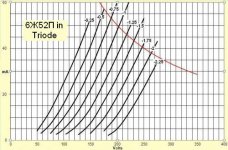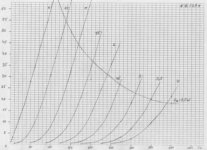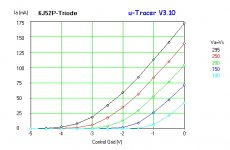I don't see why not. It looks like a big brother to the 6Ж51П, and looks like it'll actually make a good driver. Anecdotally, at least, it seems to be a good-sounding tube – "at least as good as D3a" according to a Croation discussion (of it triode-strapped operation) at "diyaudio.com.hr"I just ran a curve trace on the 6J52P, and while it's linearity is good I don't think it is a good choice to drive the GM70 directly.
Here are triode specs:
µ = 70-80
Rp ≈ 1.6K
Ep(max) = 350V
Ip(max) = 70mA
Wp(max) = 10W

Looks okay for a single-stage input/driver tube for GM-70. They're also supposed to be very long-lived – 10,000 hours typically (although there are various reports of microphony after 1000-2000 hours).
Of course, my vote would still be 6C45П, as it's a true triode
 , but that's just me.
, but that's just me.
Last edited:
Based on the curves I took it looked that way, but I see that the maximum plate voltage is 350V operating so I will rerun the curves and post them here. (What I interpreted as typical Vp led me astray) I think somewhat < 5W dissipation is probably realistic for long term use, but who knows.
Edit: I've added a new curve. The limit of my curve tracer is somewhere just below 300V.. (Current limit is 200mA)
Edit: I've added a new curve. The limit of my curve tracer is somewhere just below 300V.. (Current limit is 200mA)
Attachments
Agreed....I think somewhat < 5W dissipation is probably realistic for long term use, but who knows.

Looks like you could do a B+ of 300V (plate max is 350V, G2 is 250V) and sit pretty nicely at -1.5 to -1.7Vg @ 20mA (somewhere around 175V), giving you 120V or more in either direction with a CCS.
Last edited:
I just ran a curve trace on the 6J52P, and while it's linearity is good I don't think it is a good choice to drive the GM70 directly. The curves will tell the story.
I attempted to trace it pentode connected, but did not find a good combination of fixed screen voltage and grid bias in the time I had available. (It would have helped to look at the data sheet.)
Yagoolar perhaps you could provide a partial translation of the data sheet? There are some parts I don't follow.
Please, point to which parts I should translate and I will.
Edit: I am sometimes lazy, therefore I have found 6z52p specs in Russian and English.
Source: http://www.mif.pg.gda.pl/homepages/frank/sheets/112/6/6Z52P.pdf
Attachments
Last edited:
Forum member JohannB made direct measurements of C g-a of some of these high gm pentodes, triode-wired, in a thread a few years ago. In every case the result was much higher than the published (presumably high frequency) specs and so would be a rather high reactive load. Would the folded cascode, which seems popular here in a rather different context, be appropriate, perhaps followed by a FQP2N80C source follower if a suitable pnp device could be found? The extra gain could be spent on feedback.
Yes, I found this to my chagrin in a phono stage where I used a triode connected D3A in the front end - the miller capacitance is really up there. In an application like this there should be no issue as long as the driving source impedance is reasonable. For example my 26 based line stage uses a plate to line transformer and has a source impedance of < 400 ohms driving a triode connected D3A. The Salas 6V6 line stage would be another that should have no problems driving this sort of load.
Please, point to which parts I should translate and I will.
Edit: I am sometimes lazy, therefore I have found 6z52p specs in Russian and English.
Source: http://www.mif.pg.gda.pl/homepages/frank/sheets/112/6/6Z52P.pdf
The bilingual data sheet solves the problem..
Obviously no problem there(post 127). If the 6j52p is like the e810f (now quite expensive) then its gm will be quite high at moderately low current, which would be an advantage. Looking at the constant Va curves that you have kindly produced suggests that it would perform very well in the hybrid topology(again assuming a suitable pnp device)
Yagoolar wants to be able to drive the GM-70 to full output off of 2V.How about an E55L in triode or pentode mode. Gain of 33 in triode at 50mA plate current. Very linear to boot. Not cheap though and not DHT.
Shoog
He needs µ of 60 or better to be safe.
The 6J52P will have a mu of >70 at any reasonable operating point based on a quick measurement last night..
The GM70 is quite a bit easier to drive than the 845 due to its significantly higher mu (about twice) staying away from A2 means that drive requirements are no worse than for a 300B. (Say somewhere in the vicinity of 200Vpp) The linearity of the GM70 is impressive..
The GM70 is quite a bit easier to drive than the 845 due to its significantly higher mu (about twice) staying away from A2 means that drive requirements are no worse than for a 300B. (Say somewhere in the vicinity of 200Vpp) The linearity of the GM70 is impressive..
Has he rejected a pentode driver ?Yagoolar wants to be able to drive the GM-70 to full output off of 2V.
He needs µ of 60 or better to be safe.
Shoog
14 posts ago:The 6J52P will have a mu of >70 at any reasonable operating point based on a quick measurement last night..
...
Here are triode specs:
µ = 70-80
Rp ≈ 1.6K
Ep(max) = 350V
Ip(max) = 70mA
Wp(max) = 7-10W...
We already discussed that possibility – yagoolar was considering 4П1Л, but since it would have to be pentode (gain wise), I thought 12GN7 might be a better choice.Has he rejected a pentode driver ?
Shoog
In the final analysis, 6Ж52П (triode-strapped) or a "hot" 6C45П (true triode) look to be strong options for price/performance IMHO.
Yagoolar, I think the plate limit on 6С4П is 160V and you'll probably need a B+ of 300V or more to get the voltage swing you need, so I'd stick with 6С45П (max. V = 250V IIRC) if you want to stay all-triode. (Plus, 6С45П's seem to average higher µ's).
Anyway, please let us know what you end up doing and how it turns out.
Good luck.
Anyway, please let us know what you end up doing and how it turns out.
Good luck.
Last edited:
I'd consider the miller capacitance impact if triode stage is your choice. You will need a good line stage to drive the 6c45p to full swing nicely.
What about pentode option or a lower gain triode plus input step up Transformer?
Something like LL7903 works brilliantly and provides some galvanic isolation at the input which is a plus... Just a suggestion to stimulate thinking
Ale
What about pentode option or a lower gain triode plus input step up Transformer?
Something like LL7903 works brilliantly and provides some galvanic isolation at the input which is a plus... Just a suggestion to stimulate thinking
Ale
- Status
- This old topic is closed. If you want to reopen this topic, contact a moderator using the "Report Post" button.
- Home
- Amplifiers
- Tubes / Valves
- Winter is coming... Time to start GM70 SE parafeed amp
